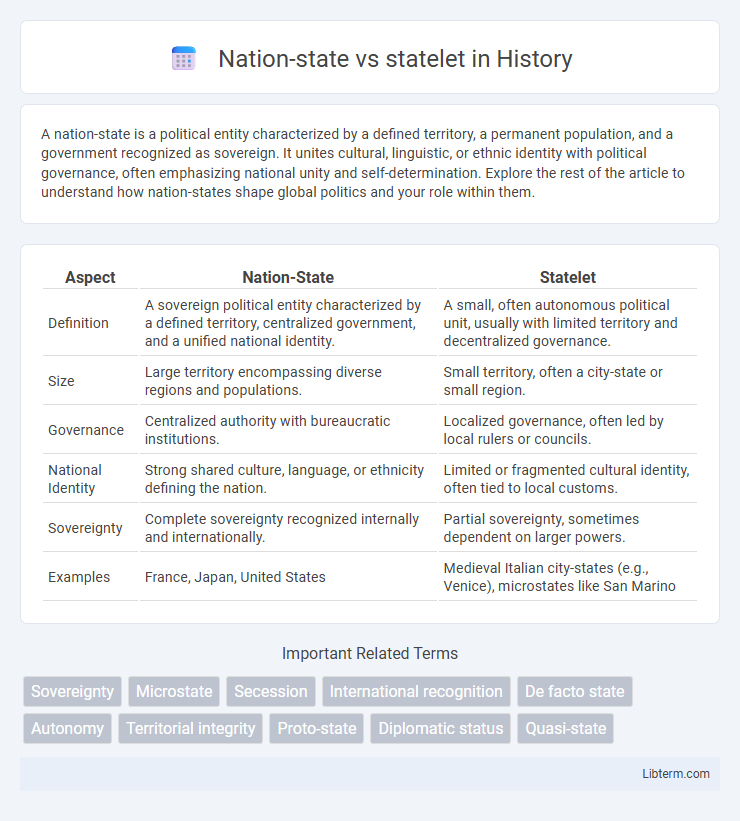A nation-state is a political entity characterized by a defined territory, a permanent population, and a government recognized as sovereign. It unites cultural, linguistic, or ethnic identity with political governance, often emphasizing national unity and self-determination. Explore the rest of the article to understand how nation-states shape global politics and your role within them.
Table of Comparison
| Aspect | Nation-State | Statelet |
|---|---|---|
| Definition | A sovereign political entity characterized by a defined territory, centralized government, and a unified national identity. | A small, often autonomous political unit, usually with limited territory and decentralized governance. |
| Size | Large territory encompassing diverse regions and populations. | Small territory, often a city-state or small region. |
| Governance | Centralized authority with bureaucratic institutions. | Localized governance, often led by local rulers or councils. |
| National Identity | Strong shared culture, language, or ethnicity defining the nation. | Limited or fragmented cultural identity, often tied to local customs. |
| Sovereignty | Complete sovereignty recognized internally and internationally. | Partial sovereignty, sometimes dependent on larger powers. |
| Examples | France, Japan, United States | Medieval Italian city-states (e.g., Venice), microstates like San Marino |
Defining Nation-State and Statelet
A nation-state is a sovereign political entity characterized by a unified population sharing common cultural, linguistic, or ethnic identity, often with established institutions and defined territorial boundaries. A statelet is a smaller, less influential political unit with limited sovereignty, often lacking full international recognition or robust governmental structures. The key difference lies in the nation-state's comprehensive political autonomy and cohesive national identity compared to the more fragmented, unstable nature of a statelet.
Historical Origins of Nation-States
The historical origins of nation-states trace back to the Treaty of Westphalia in 1648, which established principles of territorial sovereignty and political autonomy, differentiating nation-states from smaller political entities known as statelets. Nation-states consolidate centralized authority over defined geographic borders, fostering a unified national identity, whereas statelets often represent fragmented, semi-autonomous regions lacking complete sovereignty. This evolution marks a shift from feudal and tribal allegiances to modern political organization, emphasizing centralized governance and national self-determination.
The Emergence of Statelets
The emergence of statelets marks the initial phase in the evolution of political organization characterized by small, often ethnically homogeneous entities with limited territorial control and governance structures. Unlike fully developed nation-states, statelets lack centralized authority, extensive administrative systems, and widespread recognition, often functioning through localized power networks. This fragmented political landscape typically arises in regions undergoing social complexity increases, where kinship ties, tribal affiliations, or religious identities predominantly influence governance.
Legal Status and International Recognition
Nation-states possess full legal sovereignty and are widely recognized as independent entities under international law, allowing them to enter treaties, join international organizations, and exercise control over defined territories. Statelets often lack complete sovereignty, face limited or disputed legal status, and struggle to gain international recognition, resulting in constrained diplomatic relations and limited participation in global institutions. The distinction between nation-state and statelet hinges on the degree of recognized autonomy, the effectiveness of governance structures, and acceptance by the international community.
Governance Structures: Nation-State vs Statelet
Nation-states feature centralized governance structures with a unified legal system, bureaucracy, and sovereign authority overseeing defined territorial boundaries. Statelets operate with fragmented or decentralized governance, often lacking a comprehensive legal framework and exhibiting varied degrees of autonomy within limited territories. Nation-states maintain stable institutions ensuring law enforcement and policy implementation, whereas statelets experience fluid governance prone to local power shifts and weaker administrative cohesion.
Territorial Integrity and Sovereignty
Nation-states maintain clear territorial integrity with internationally recognized borders, ensuring full sovereignty over their land and governance. Statelets, often characterized by limited territorial control and ambiguous boundaries, face challenges in asserting complete sovereignty and political legitimacy. This disparity affects their ability to enforce laws, manage resources, and engage in diplomatic relations on equal footing with established nation-states.
Economic Viability and Resource Management
Nation-states typically exhibit greater economic viability due to larger, diversified economies and sophisticated resource management systems, enabling sustained growth and stability. Statelets often face challenges in maintaining economic independence, relying heavily on external support or limited local resources, which constrains development prospects. Effective resource management in nation-states includes strategic planning, infrastructure investment, and regulatory frameworks that optimize natural and human capital utilization.
Identity, Nationalism, and Cultural Cohesion
Nation-states exhibit strong national identity, uniting people through shared language, history, and cultural norms that foster deep nationalism and cohesive citizenship. Statelets, in contrast, often lack extensive cultural cohesion and a unified national identity, resulting in weaker nationalist sentiments and more fragmented social structures. The presence of a dominant cultural narrative in nation-states promotes political stability and collective solidarity, whereas statelets may struggle with internal divisions and limited scope of identity.
Case Studies: Successful and Disputed Statelets
Successful statelets like Monaco and Singapore demonstrate economic resilience and political stability despite limited geographic area and population. In contrast, disputed statelets such as Somaliland and Transnistria face challenges in gaining international recognition due to contested sovereignty and ongoing conflicts. Case studies reveal that economic viability and diplomatic engagement are critical factors influencing the success or dispute status of statelets.
Geopolitical Implications and Future Trends
Nation-states possess centralized governance structures and cohesive national identities, enabling more effective control over territories and international diplomacy, whereas statelets often face challenges in sovereignty and recognition, leading to geopolitical fragility. The rise of statelets can disrupt regional stability by fostering contested borders and fueling micro-nationalism, which complicates conflict resolution and global power dynamics. Future trends suggest increasing tensions as global powers navigate the legitimacy and strategic value of emerging statelets against established nation-states, with implications for international law and alliance formations.
Nation-state Infographic

 libterm.com
libterm.com